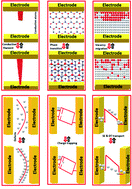Novel charm of 2D materials engineering in memristor: when electronics encounter layered morphology
Abstract
The family of two-dimensional (2D) materials composed of atomically thin layers connected via van der Waals interactions has attracted much curiosity due to a variety of intriguing physical, optical, and electrical characteristics. The significance of analyzing statistics on electrical devices and circuits based on 2D materials is seldom underestimated. Certain requirements must be met to deliver scientific knowledge that is beneficial in the field of 2D electronics: synthesis and fabrication must occur at the wafer level, variations in morphology and lattice alterations must be visible and statistically verified, and device dimensions must be appropriate. The authors discussed the most recent significant concerns of 2D materials in the provided prose and attempted to highlight the prerequisites for synthesis, yield, and mechanism behind device-to-device variability, reliability, and durability benchmarking under memristors characteristics; they also indexed some useful approaches that have already been reported to be advantageous in large-scale production. Commercial applications, on the other hand, will necessitate further effort.



 Please wait while we load your content...
Please wait while we load your content...